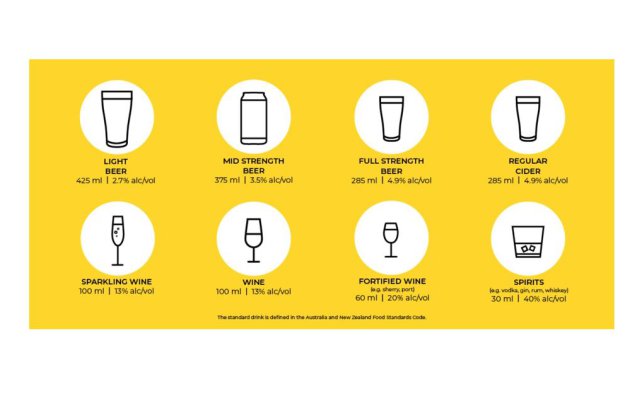
Alcohol is the most widely used drug in Australia with people consuming alcohol for a variety of reasons, and in different social and cultural contexts. Alcohol can cause harm to the person who drinks and sometimes to others around them.
The consumption of alcohol has been linked to increased risk of injury, chronic disease and early death. A number of short and long term adverse health outcomes have also been linked to alcohol consumption, including:
- Cancer in the mouth and pharynx, larynx, oesophagus, breast, liver, stomach, and bowel.
- Cardiovascular disease and stroke
- Liver cirrhosis and disease
- Mental health problems
- Alcohol use disorders
- Intentional injury (e.g. self harm and suicide)
- Unintentional injury
- Traffic incidents (e.g. car crash)
- Family, domestic, and sexual violence
- Harm to unborn babies, infants, and children (e.g. fetal spectrum disorder) (2).
The National Health and Medical Research Council (NHMRC) has developed the following evidence based guidelines to reduce health risks from drinking alcohol. These guidelines aim to help people make an informed decision about how much alcohol they drink, if any.
Guideline 1: Reducing the risk of alcohol-related harm for adults
To reduce the risk of harm from alcohol-related disease or injury, healthy men and women should drink no more than 10 standard drinks a week and no more than 4 standard drinks on any one day.
The less you drink, the lower your risk of harm from alcohol.
Guideline 2: Children and people under 18 years of age
To reduce the risk of injury and other harms to health, children and people under 18 years of age should not drink alcohol.
Guideline 3: Women who are pregnant or breastfeeding
A. To prevent harm from alcohol to their unborn child, women who are pregnant or planning a pregnancy should not drink alcohol.
B. For women who are breastfeeding, not drinking alcohol is safest for their baby (1).

As defined by the NHMRC, "a standard drink contains 10 grams of pure alcohol". Whether in beer, wine or spirits, the type of alcohol makes no difference, meaning that 10 grams of alcohol is 10 grams of alcohol. In addition, a standard drinks remain the same, regardless of also soft drink, fruit juice, water or ice that is added.
The following examples have been included to demonstrate what a standard drink looks like in different types of alcohol.
- Light beer (2.7% alc/vol) 425 mL
- Mid strength beer (3.5% alc/vol) 375 mL
- Full strength beer (4.9% alc/vol) 285 mL
- Regular cider (4.9% alc/vol) 285 mL
- Sparkling wine (13% alc/vol) 100 mL
- Wine (13% alc/vol) 100 mL
- Fortified wine e.g. sherry, port (20% alc/vol) 60 mL
- Spirits e.g. vodka, gin, rum, whiskey (40% alc/vol) 30 mL
In an emergency call 000 or visit your local emergency department.
Support is available through many services operating across WA. If you are concerned about your own or another person's alcohol or drug use, you can get help by:
- Calling a helpline
- If you are wanting to speak to someone, helplines have someone available to listen, provide advice, information, and referrals to you.
- Searching the My Services online directory
- Accessing this directory will help you find the right mental health support for you.
- Visiting your General Practitioner (GP)
- Making an appointment with your GP to get the advice, and support is another option.
- Seeking support online via live chat and online forums
- Many of the organisations who run helplines have live chat and online forums available as an alternative (3).
(1). National Health and Medical Research Council (2022). Australian guidelines to reduce health risks from drinking alcohol. Retrieved from: https://www.nhmrc.gov.au/health-advice/alcohol
(2). Alcohol Think Again (2022). Alcohol & Your Health. Retrieved from: https://alcoholthinkagain.com.au/alcohol-your-health/
(3). Mental Health Commission (2022). Getting help – finding a service. Retrieved from: https://www.mhc.wa.gov.au/getting-help/


X Prohibited Burning Period has been extended until 28 April 2024. READ MORE